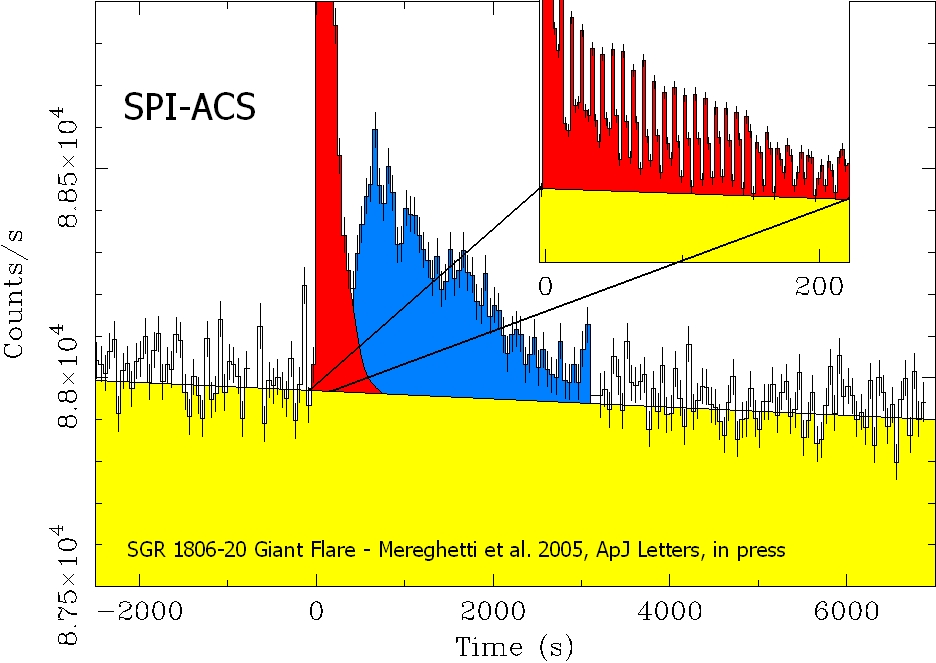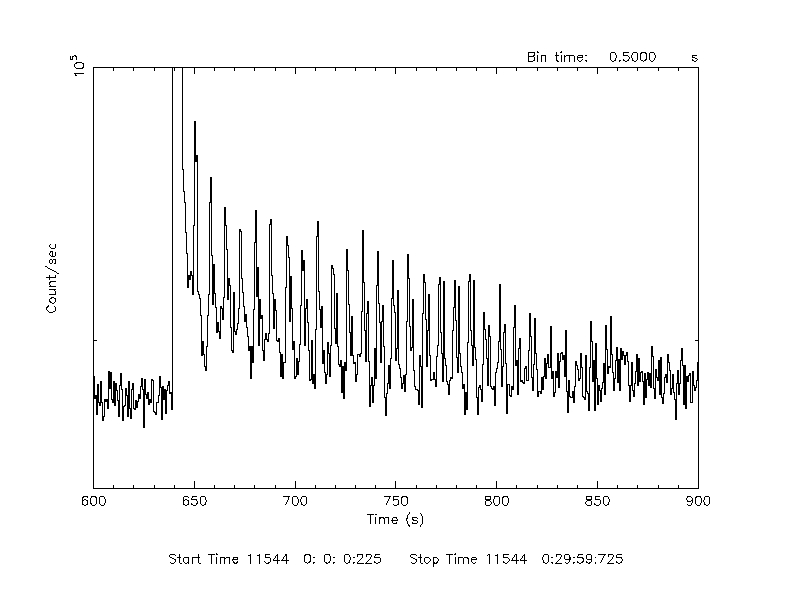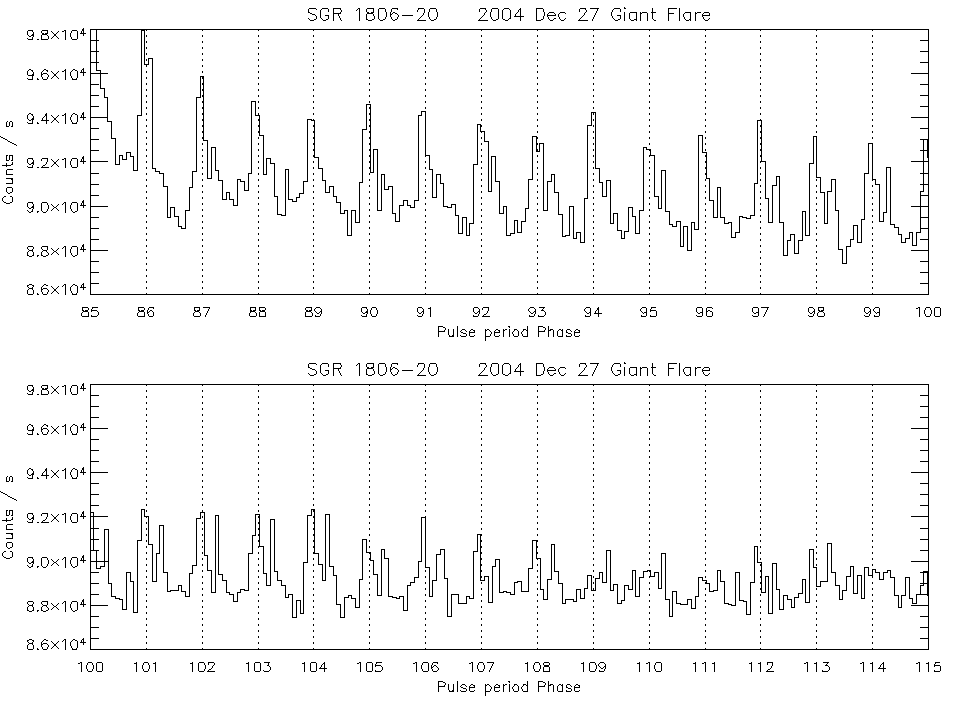

|
|
A new version of the IBAS Alert Distribution system is operational at the INTEGRAL Science Data Center. In addition to the already available functionalities, the new version distributes in real time also Alert Packets for low significance triggers discovered in the field of view of the IBIS imager. The new Alert Packets are called WEAK Alerts and are identified by the field PKT_TYPE=6
Many WEAK alerts will be produced by statistical fluctuations, but there is also a non negligible probability that some of them are due to real astrophysical events. In most cases it is not possible to recognize the GRBs based only on the INTEGRAL data, but the detection of afterglows could confirm some of these events as genuine GRBs.
Several bursts that were confirmed by off-line interactive analysis of the INTEGRAL data produced triggers above the threshold currently adopted for the WEAK alerts. Recent examples include the two short bursts GRB 100703A and GRB 110112B and the long burst GRB 100909A .
WEAK Alert Packets provide a single sky position, with error radius smaller than 4 arcmin. They are intended for robotic telescopes which can react without a negative impact on scheduled observing programmes. The value of SIGMA in the WEAK Alert Packet can be used as a figure of merit.
WEAK Alert Packets may or may not be followed by the usual WAKEUP and/or REFINED Alert Packets, depending on the evolution of the detected signal. WEAK alerts for events belows WAKEUP threshold are neither confirmed nor cancelled with an OFFLINE packet.
The threshold for the distribution of the high significance IBAS triggers remains unchanged at
SIGMA= 8.0 (Alert Packets with PKT_TYPE= 3 (WAKEUP))
while the threshold for the distribution of low significance IBAS triggers is currently set at
SIGMA= 6.5 (Alert Packets with PKT_TYPE= 6 (WEAK))
This threshold corresponds to a rate of a few WEAK Alert Packets per week, but it could be adjusted in the future.
It is recommended that current ibas clients upgrade their IBAS Client Software to the version 2.1.0 (available here) although the previous versions should process WEAK alert without problems.
For more information contact Sandro Mereghetti (sandro at iasf-milano.inaf.it)
As a result of a major network restructuring at the University of Geneva, the IBAS alert server IP address changed from
129.194.67.222 (current IP address)
to
129.194.168.222 (new IP address)
The change took place during INTEGRAL's perigee passage #0339 on July 26 2005.
Swift has opened a new era in data right policies: all
the Swift GRB data are public and the information derived by the teams
of the Swift instruments is immediately disseminated through GCN
circulars.
The IBAS Team, supported by several scientists of the GRB community,
proposed that a similar policy be applied to all the INTEGRAL GRB data.
This issue was discussed by the members of the INTEGRAL Science Working
Team (ISWT) who could not approve it since that would violate the
rights of accepted guest observers proposals.
However, the ISWT allowed to quickly release more information resulting
from the IBAS off-line analysis. The PI's with accepted AO3 proposals
on GRBs agreed with this new policy. Following this decisions, in
addition to the results distributed for INTEGRAL GRBs up to now
(position, duration and peak flux), also the total fluence, peak energy
(if it can be determined) and light curve (in the 20-200 keV)
will be communicated by the
IBAS Team as soon as they can be derived.
Many satellites observed the December 27 Giant Flare and provided a wealth of new results, such as the burst spectrum, the determination of the total emitted energy (SPI-ACS could provide only a lower limit due to the saturation of the instrument) and the pulse shape of the tail (e.g. Hurley et al. 2005 (RHESSI); Palmer et al. 2005 (Swift)). The SPI-ACS, however, has two advantages compared to the other satellites: its large effective area above 80 keV and the INTEGRAL orbit which allows for long uninterrupted observations. Thanks to these unique properties, the ACS was able to measure a second component after the pulsating tail (t > 400 s). As visible in the figure (yellow: instrumental background, red: Flare tail, blue: high-energy afterglow), the count rate increased again, forming a long bump which peaked around t~700 s and returned to the pre-flare background level at t~3000-4000. The most likely association of this long lasting component to SGR 1806-20 is discussed in a Letter recently accepted for publication in The Astrophysical Journal (Mereghetti et al. 2005).

The case of GRB 041219A demonstrates once more that INTEGRAL GRBs can be very interesting: thanks to the rapid IBAS localization of this long lasting burst, the RAPTOR automatic telescope could observe it in the optical simultaneously with the gamma-ray emission. This is only the second burst for which the prompt optical emission has been observed. Surprisingly the properties in the optical of these two bursts are very different (see the paper by Vestrand et al. 2005 to appear in Nature). GRB 041219A was also seen by Swift, which had been launched just one month earlier, but was not yet distributing localizations in real time.
The first Giant Flare from the soft gamma-ray repeater SGR 1806-20
has been discovered with INTEGRAL on December 27 (see GCN
Circ. 2920).
The IBAS programs monitoring the light curves of the SPI ACS triggered
on a short event at 21:28:02 UT (see
light curve
) also seen by Konus-Wind
(GCN Circ. 2922).
About 143 seconds later a rapid increase in the
SPI ACS count rate was detected.

In less than 150 msec the flux reached a peak count rate of
2x10^6 counts/s (compared to a background level of 88,000 counts/s ).
The initial spike, lasting about
1.5 s, was followed by a long tail in which pulsations at 7.57 s are
clearly detected.

The flux decline is well fit by an exponential with decay time of about 80 s.
Variations in the shape of the pulse profile are also visible.

The IBAS users interested in alerts from non-GRB sources should register at the ISDC Web pages in order to select the classes of sources of interest. They can also download a new version of the IBAS Client Software (although not stricly needed, this will allow them to fully exploit the new information in the Alert Packets for non-GRB sources).
The IBAS users interested in Alerts only for Gamma-Ray Bursts will continue to receive them, without the need of installing the new version of the IBAS Client Software.
Up to now the following source classes have been defined:
A list of the sources included by IBAS in these classes can be seen below. The new Alert Packets will contain the source name and type in the comment field. They will also include an extra field containing the source type number. Backward compatibility with old versions of the IBAS Client is ensured. For further details see the IBAS Client 2.0.0 User Manual.
Future developments will include the possibility to receive Alert Packets for ''GRB candidates'', i.e. the triggers which are currently sligthly below the significance threshold for automatic alert delivery.
| Source Name | R.A. (J2000) | Dec.(J2000) |
| 4U_0512-401 | 05:14:06.6 | -40:02:37.0 |
| 4U_0614+091 | 06:17:07.3 | +09:08:13.0 |
| EXO_0748-676 | 07:48:33.8 | -67:45:09.0 |
| SAX_J0835.9+5118 | 08:35:56.0 | +51:18:36.0 |
| MX_0836-429 | 08:37:23.6 | -42:54:02.0 |
| 4U_1254-690 | 12:57:37.2 | -69:17:21.0 |
| 4U_1323-619 | 13:26:36.1 | -62:08:10.0 |
| Cen_X-4 | 14:58:22.0 | -31:40:08.0 |
| Cir_X-1 | 15:20:40.9 | -57:10:01.0 |
| SAX_J1603.9-7753 | 16:03:54.0 | -77:53:06.0 |
| 4U_1608-522 | 16:12:43.0 | -52:25:23.0 |
| 4U_1636-536 | 16:40:55.5 | -53:45:05.0 |
| 1658-298 | 17:02:06.3 | -29:56:45.0 |
| 4U_1702-429 | 17:06:15.3 | -43:02:10.0 |
| 4U_1705-440 | 17:08:54.7 | -44:06:02.0 |
| XTE_J1709-267 | 17:09:30.2 | -26:39:27.0 |
| SAX_J1712.6-3739 | 17:12:34.0 | -37:38:36.0 |
| 2S_1715-321 | 17:18:47.4 | -32:10:40.0 |
| RXS_J171824.2-402934 | 17:18:24.1 | -40:29:30.4 |
| XTE_J1723-376 | 17:23:38.0 | -37:39:42.0 |
| 1724-307 | 17:27:33.2 | -30:48:07.0 |
| GX354-0 | 17:31:57.4 | -33:50:05.0 |
| Rap_Busrt(1730-335) | 17:33:24.1 | -33:23:16.0 |
| KS_1731-260 | 17:34:13.0 | -26:05:09.0 |
| 1732-304 | 17:35:47.6 | -30:28:56.0 |
| SLX_1735-269 | 17:38:16.0 | -27:00:16.0 |
| 4U_1735-444 | 17:38:58.3 | -44:27:00.0 |
| KS_1741-293 | 17:44:49.0 | -29:21:06.0 |
| GRS_1741.9-2853 | 17:45:01.0 | -28:54:06.0 |
| A_1742-289 | 17:45:37.0 | -29:01:07.0 |
| A_1742-294 | 17:46:05.5 | -29:30:54.8 |
| SAX_J1747.0-2853 | 17:47:02.0 | -28:52:30.0 |
| GRO_J1744-28 | 17:44:33.1 | -28:44:27.0 |
| SLX_1744-300 | 17:47:25.9 | -30:02:31.0 |
| GX3+1 | 17:47:56.0 | -26:33:49.0 |
| EXO_1745-248 | 17:48:05.0 | -24:46:47.0 |
| 4U_1746-370 | 17:50:12.7 | -37:03:08.0 |
| EXO_1747-214 | 17:50:25.7 | -21:25:21.0 |
| SAX_J1748.9-2021 | 17:48:53.4 | -20:21:43.0 |
| SAX_J1750.8-2900 | 17:50:24.0 | -29:02:18.0 |
| SAX_J1752.3-3138 | 17:52:24.0 | -31:37:42.0 |
| XTE_J1806-246 | 18:06:50.7 | -24:35:29.0 |
| SAX_J1808.4-3658 | 18:08:27.5 | -36:58:44.3 |
| SAX_J1810.8-2609 | 18:10:44.5 | -26:09:01.0 |
| GX13+1 | 18:14:31.1 | -17:09:26.0 |
| 4U_1812-12(Ser_X-2) | 18:15:12.0 | -12:05:00.0 |
| GX17+2 | 18:16:01.4 | -14:02:11.0 |
| 4U_1820-303 | 18:23:40.6 | -30:21:41.0 |
| GS_1826-238 | 18:29:28.2 | -23:47:49.1 |
| XB_1832-330 | 18:35:43.6 | -32:59:26.8 |
| Ser_X-1 | 18:39:57.5 | +05:02:09.0 |
| 4U_1850-087 | 18:53:04.9 | -08:42:20.0 |
| 4U_1905+000 | 19:08:27.0 | +00:10:08.0 |
| Aql_X-1 | 19:11:16.0 | +00:35:06.0 |
| 4U_1916-053 | 19:18:48.0 | -05:14:09.0 |
| XTE_J2123-058 | 21:23:14.5 | -05:47:52.9 |
| 4U_2127+119 | 21:29:58.3 | +12:10:03.0 |
| 4U_2129+470 | 21:31:26.2 | +47:17:24.0 |
| Cyg_X-2 | 21:44:41.2 | +38:19:18.0 |
| SAX_J1753.5-2349 | 17:53:34.0 | -23:49:24.0 |
| SAX_J1806.5-2215 | 18:06:34.0 | -22:15:06.0 |
| 2S_1711-339 | 17:14:18.9 | -34:02:57.6 |
| SLX_1737-282 | 17:40:43.0 | -28:18:12.0 |
| SAX_J1324.5-6313 | 13:24:27.0 | -63:13:24.0 |
| SAX_J1818.7+1424 | 18:18:44.0 | +14:24:12.0 |
| SAX_J1828.5-1037 | 18:28:33.0 | -10:37:48.0 |
| SAX_J2224.9+5421 | 22:24:52.0 | +54:21:54.0 |
| 2S_0918-549 | 09:20:26.7 | -55:12:23.9 |
| Source Name | R.A. (J2000) | Dec.(J2000) |
| SGR_0418+4729 | 04:18:34.1 | +57:32:24.5 |
| SGR_0501+4516 | 05:01:06.7 | +45:16:34.4 |
| SGR_0525-66 | 05:25:57.0 | -66:07:06.0 |
| SGR_1806-20 | 18:08:39.3 | -20:24:39.5 |
| SGR_1900+14 | 19:07:14.9 | +09:19:41.9 |
| SGR_1627-41 | 16:35:49.8 | -47:35:44.0 |
| SGR_1801-23 | 18:00:58.9 | -22:56:48.5 |
| SGR_1833-0832 | 18:33:44.45 | -08:31:08.0 |
| CXO_0100-7211 | 01:00:43.1 | -72:11:33.8 |
| 4U_0142+614 | 01:46:22.4 | +61:45:02.8 |
| 1E_1048-5937 | 10:50:07.1 | -59:53:21.4 |
| 1E_1547.0-5408 | 15:50:54.1 | -54:18:23.7 |
| CXOU_J1647-45 | 16:47:10.2 | -45:52:16.9 |
| RXS_J1708-40 | 17:08:46.9 | -40:08:52.4 |
| XTE_J1810-197 | 18:09:51.1 | -19:43:51.7 |
| 1E_1841-045 | 18:41:19.3 | -04:56:11.2 |
| AX_J1844-0258 | 18:44:53.0 | -02:56:40.0 |
| 1E_2259+586 | 23:01:08.3 | +58:52:44.5 |
|
Last modified: 22-Feb-2011 |
Page maintained by: Sandro Mereghetti and Diego Götz |